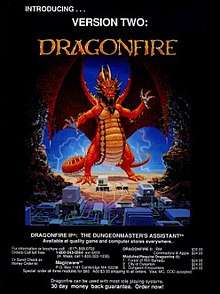Dragonfire II: The Dungeonmaster's Assistant
Dragonfire II: The Dungeonmaster's Assistant is a computer program published by Magicware for Apple, Commodore and IBM Personal Computers in 1985. The program, and its predecessor, were designed by Erik Brynjolfsson, who is now an MIT professor.[1] Dragonfire II was written by Steven Bergstein, who worked for Magicware and Brynjolfsson at the time.
| Dragonfire II: The Dungeonmaster's Assistant | |
|---|---|
 | |
| Developer(s) | Erik Brynjolfsson, Steven Bergstein |
| Publisher(s) | Magicware |
| Platform(s) | Apple, Commodore, IBM Personal Computer |
| Release | 1985 |
Use
The program is designed to assist a game master in managing table-top role-playing games such as Dungeons & Dragons and Tunnels & Trolls. A user can enter material into the menu-driven program's tables, including random monster appearances, treasure tables, battle elements, and the creation of new monsters and characters.[2] The software allowed users to customize templates, permitting them to modify the system so that it would generate characters, encounters and other game requirements for a multiple role playing systems.[3]
Reception
The software was reviewed in 1986 in Dragon #116 by Hartley and Pattie Lesser in "The Role of Computers" column. The reviewers concluded that "This program is highly recommended to all."[2] Another 1986 review, in Computer Gaming World #33, praised the software's utility, and described it as being the most flexible and thorough of the products that were available on the market at the time.[3]
See also
References
- http://digital.mit.edu/erik/Brynjolfsson%20vita%202009-02.pdf%5B%5D
- Lesser, Hartley and Pattie (December 1986). "The Role of Computers". Dragon (116): 69–76.
- Trunzo, James V. (1986). "Dragonfire II". Computer Gaming World (33): 54–55.